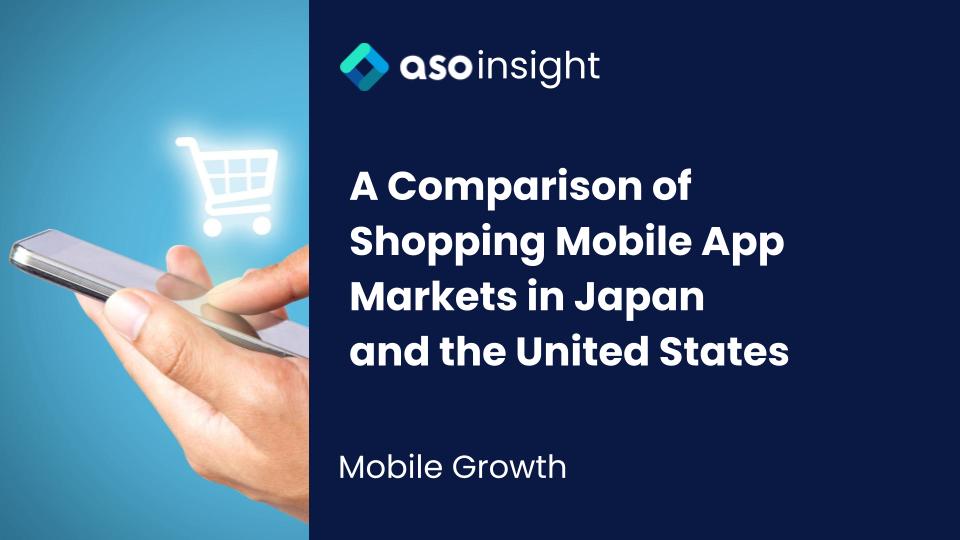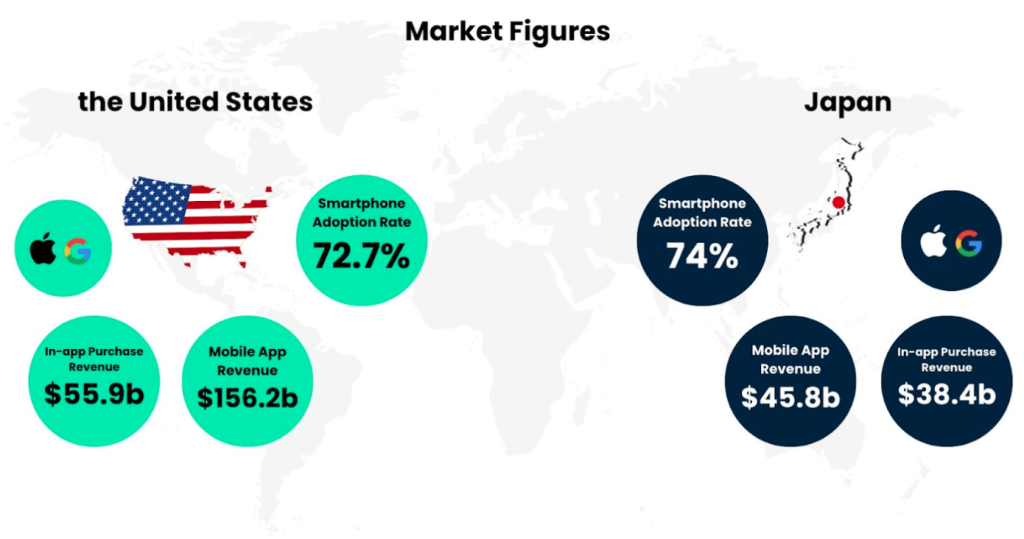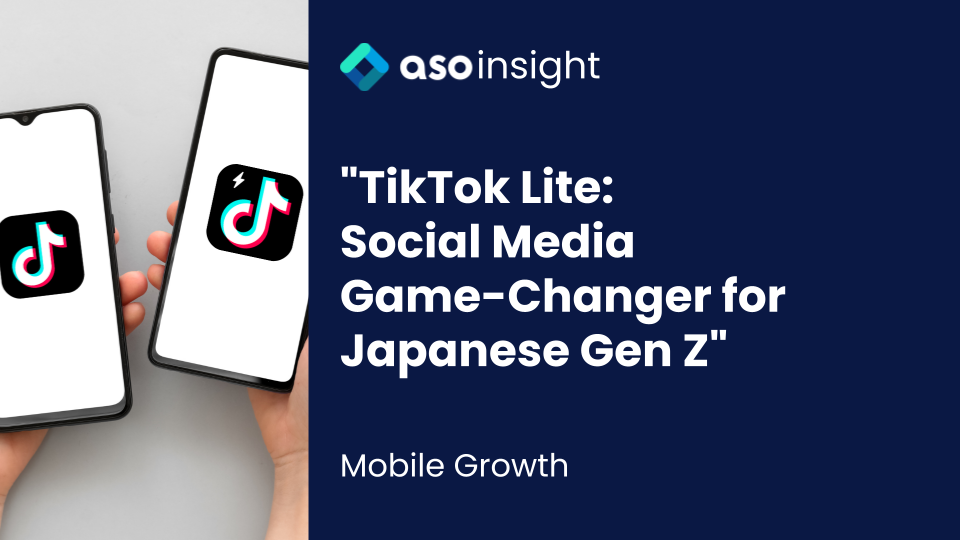Introduction
Mobile apps have revolutionized the way people shop, offering convenience, accessibility, and personalized experiences. This article delves into a comparative analysis of the shopping mobile app markets in Japan and the U.S, highlighting their market characteristics, user behavior, popular apps, and emerging trends. Understanding the similarities and differences between these markets can provide valuable insights for businesses looking to expand their presence internationally and tap into new consumer bases.
Contents
Market Characteristics
Mobile Users Ratio
When comparing the mobile app market in Japan and the United States, several key factors emerge. In terms of the ratio of mobile users, both countries boast a high level of smartphone adoption. Japan in 2021 has a market penetration rate of 74%, which is expected to continue rising in the coming years. In the US, approximately 72.7% of adults own a smartphone, highlighting the widespread use of mobile devices in both countries.
Dominant Age Group
In Japan, the mobile app market is diverse and appeals to users of various age groups. However, the younger demographic, particularly individuals in their late teens to early 30s, tends to be more active in app usage. They are early adopters of new technologies and are more likely to engage with mobile apps for social networking, entertainment, and shopping. In the United States, app usage is prevalent across different age groups, with a significant portion of the population from teenagers to middle-aged adults actively using mobile apps.
Mobile App Revenue & App Purchase
Japan’s mobile app revenue reached $45.8 billion in 2022. With a projected growth rate of 5.79% from 2022 to 2027, Japan’s app market is expected to reach a market volume of US$63.15 billion by 2027 (Statista).
In the US, the mobile app revenue estimation is $156.2b in 2022. With a CAGR of 19.5%, mobile app revenue is experiencing impressive year-over-year growth, according to Statista.
Japanese consumers have shown a propensity for investing in app purchases. Japan consistently ranks among the top countries globally, with the in-app purchase (IAP) revenue in the App market projected to reach US$38.43bn in 2022. the United States hit the amount of $55.9 also in 2022 in this sector.
Dominant Mobile OS
Examining the market share of mobile operating systems, Apple and Google dominate the mobile app landscape in both Japan and the US. In Japan, these tech giants have a significant presence in the markets for smartphones, mobile operating systems, app stores, and even smartwatches. Similarly, in the US, Apple and Google hold a firm grip on the mobile app market, indicating the strong influence and reach of these companies.
Popular Shopping Apps
Japan
- Amazon Japan: Amazon Japan is the local version of the global e-commerce giant, offering a vast selection of products, competitive prices, and fast delivery options.
- Rakuten Ichiba: Rakuten Ichiba is one of the largest online marketplaces in Japan, offering a wide range of products from various sellers. It provides a convenient and secure platform for users to shop for electronics, fashion, home goods, and more.
- Mercari: Mercari is a marketplace app that allows users to buy and sell a wide range of used and new items.
- ZOZOTOWN: ZOZOTOWN is a popular fashion-focused shopping app in Japan, known for its extensive collection of clothing, accessories, and footwear.
- Yahoo! Shopping: Yahoo! Shopping is an online shopping platform operated by Yahoo! Japan, providing access to a wide range of products from various sellers.
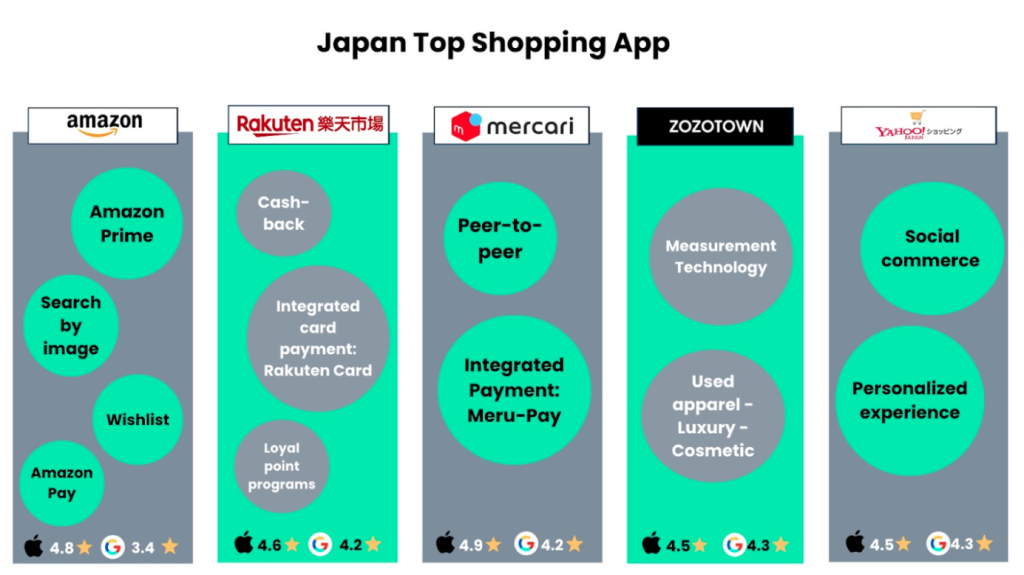
The U.S.
- Amazon: As one of the largest online marketplaces globally, Amazon offers a wide range of products and services, making it a go-to shopping app for many consumers.
- Walmart: Walmart’s mobile app allows users to shop for a variety of products, including groceries, electronics, clothing, and more. It offers convenient features such as in-store pickup and delivery options.
- eBay: eBay is a well-known online marketplace where users can buy and sell new or used items. The app provides a platform for both individual sellers and businesses to reach a wide audience.
- Target: Target’s app offers a seamless shopping experience, allowing users to browse and purchase a diverse range of products, including clothing, home goods, electronics, and more. It also provides features like personalized recommendations and easy access to weekly deals.
- Best Buy: Best Buy’s app specializes in consumer electronics and appliances, providing users with an extensive selection of products from popular brands. It offers features like product reviews, price comparisons, and the ability to schedule in-store consultations.
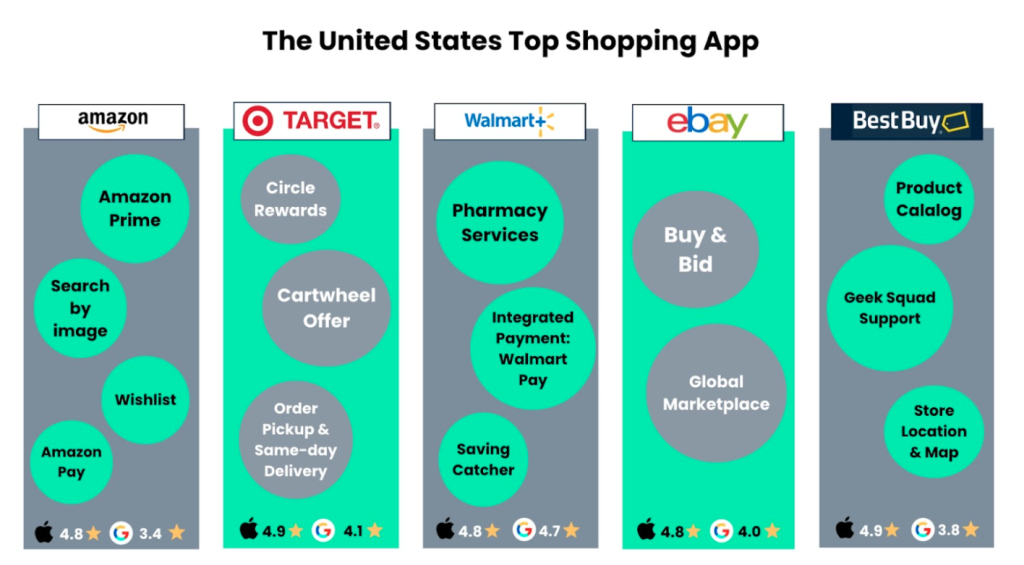
User Behavior and Preferences
For the shopping app category, consumers in Japan and the U.S exhibit distinct preferences and behaviors that reflect the unique characteristics of each market.
App Variety and Functionality
Japan: Shopping apps in Japan often offer a diverse range of features and services to cater to the unique preferences of Japanese consumers. These apps may include features like personalized recommendations, virtual fitting rooms, and integration with popular social media platforms.
The U.S.: Shopping apps in the U.S. also offer a wide variety of features, including easy browsing, product reviews, and secure payment options. Many shopping apps focus on user-friendly interfaces and seamless shopping experiences.
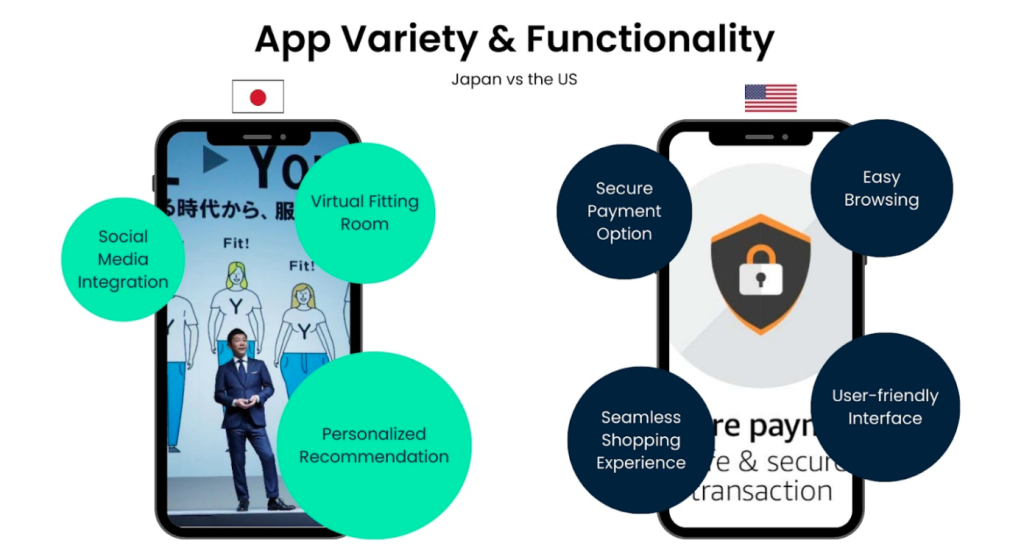
Consumer Behavior and Preferences
Japan: Japanese consumers value convenience, reliability, and a high level of customer service. They tend to prioritize quality, brand reputation, and product details when making purchasing decisions. Additionally, group buying and flash sales are popular shopping trends in Japan.
The U.S.: Western consumers prioritize a personalized shopping experience, with features like product recommendations and customer reviews playing a crucial role. They often prioritize convenience, fast shipping, and a seamless checkout process.
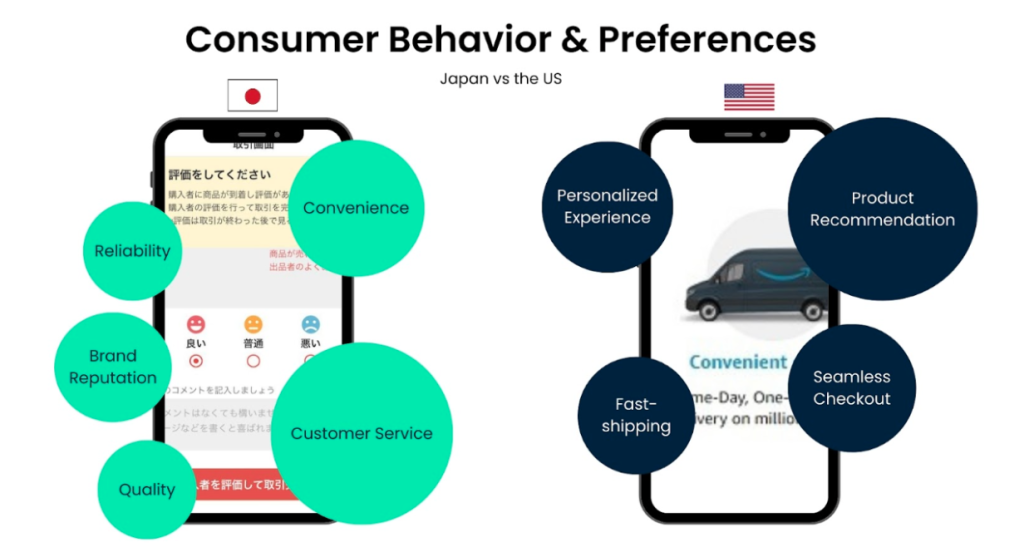
Specifically, US consumers are known for their price-consciousness and preference for discounts and deals, in which many apps optimized the function of comparing prices and reviews between products under the same category.
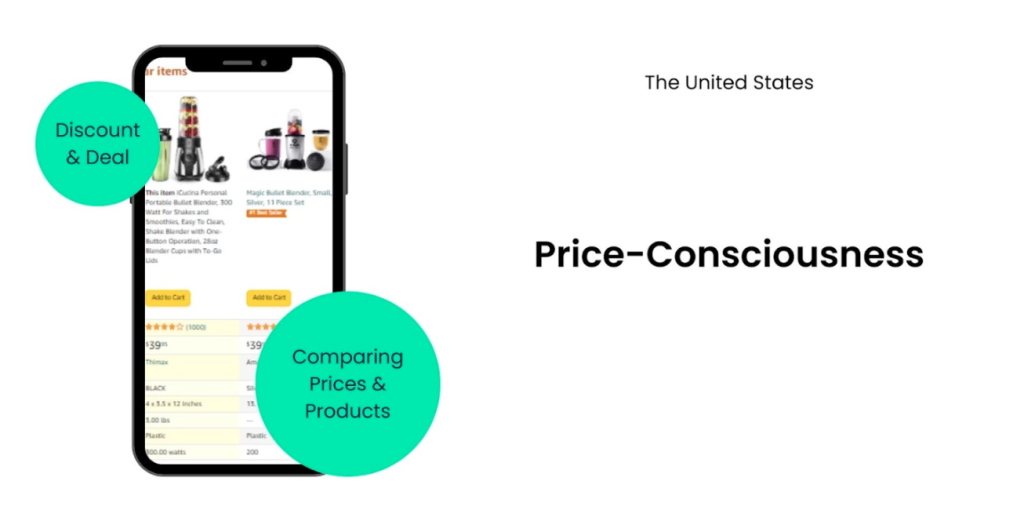
E-commerce Integration
Japan: Shopping apps in Japan often integrate with popular e-commerce platforms and marketplaces, providing users with access to a wide range of products and sellers. These apps may also incorporate loyalty programs and exclusive promotions to encourage customer engagement and repeat purchases.
The U.S.: In the U.S., shopping apps are closely integrated with various e-commerce giants and online retailers. Many apps provide a seamless shopping experience by enabling users to browse, compare prices, and make purchases directly from their preferred stores.
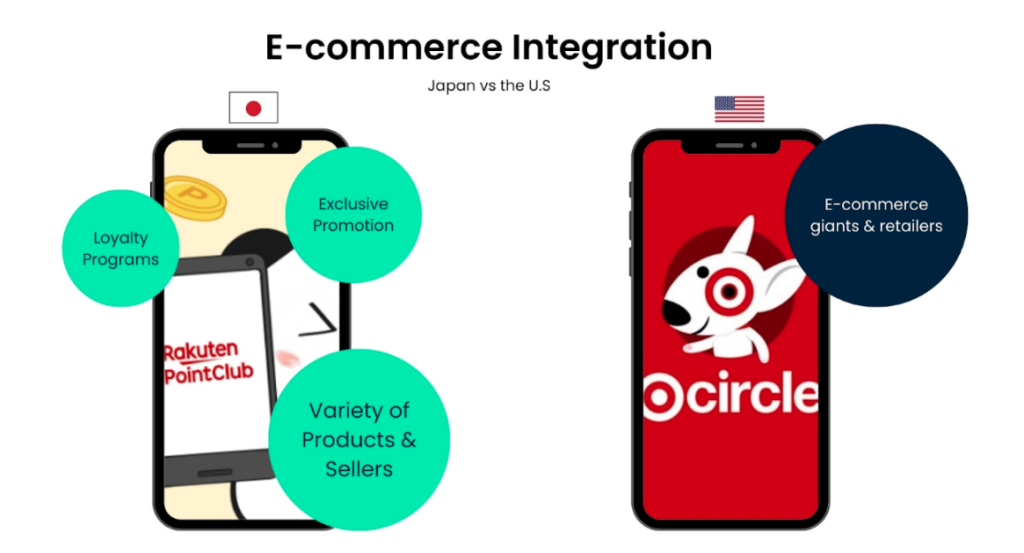
Cultural Factor
The shopping app preferences in Japan and the U.S vary significantly, reflecting the influence of their distinct cultural backgrounds. These cultural differences shape the expectations, preferences, and behaviors of consumers when it comes to mobile shopping experiences.
Collectivism vs. Individualism
In Japan, collectivism is a prominent cultural trait, emphasizing group harmony and loyalty. This influences app usage as Japanese consumers tend to rely on recommendations and reviews from their social circle, including family, friends, and online communities. Social proof and peer recommendations hold great weight in their decision-making process.
In contrast, the U.S, with a stronger emphasis on individualism, prioritize personal choices and individual preferences when selecting and using apps.
Communication and Social Interaction
Cultural differences in communication styles influence app usage in Japan and the U.S. In Japan, where face-to-face interactions and indirect communication are valued, messaging apps like LINE have gained immense popularity. These apps provide features like stickers and emoticons that enable nuanced expression and maintain social etiquette.
In the U.S, social media platforms like Facebook and Twitter serve as primary channels for communication and sharing, allowing users to connect, interact, and express themselves openly.
Privacy and Security
Cultural attitudes towards privacy and security influence app usage behaviors. In Japan, there is a general preference for privacy and data protection. App users often prioritize platforms that guarantee secure transactions, protect personal information, and offer reliable customer support.
The U.S also prioritize privacy, but there is often a greater acceptance of sharing personal data in exchange for personalized experiences and targeted advertisements.
Cultural Values and Preferences
Cultural values and preferences shape the types of apps that gain popularity in each region. In Japan, the concept of “omotenashi” (hospitality) is highly valued, leading to an emphasis on personalized and attentive customer service. This is reflected in shopping apps that offer detailed product descriptions, user reviews, and customer support options.
In the U.S, convenience, efficiency, and competitive pricing are key factors that influence app usage, with consumers gravitating towards platforms that offer fast delivery, easy returns, and competitive pricing.
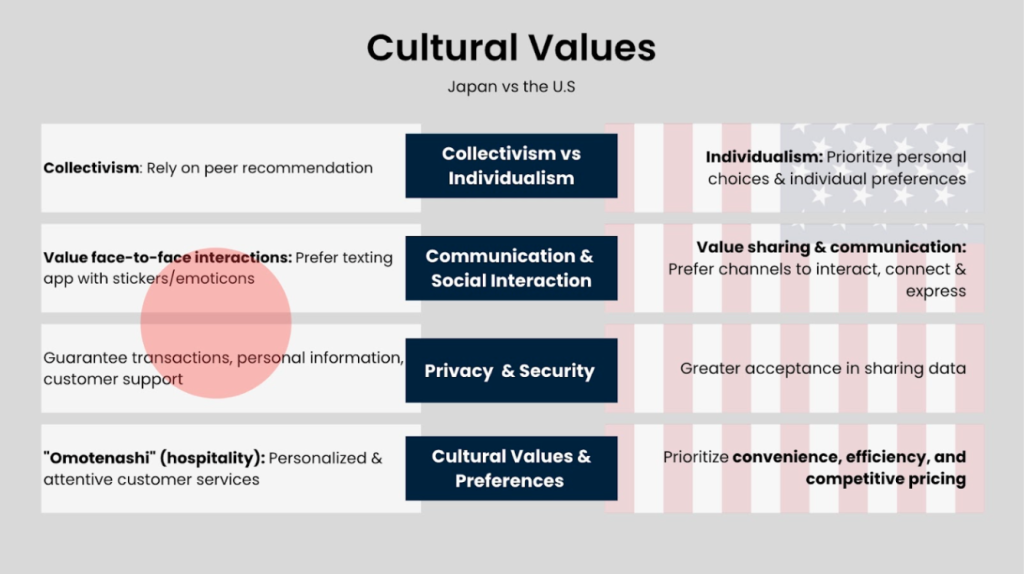
Conclusion
In conclusion, the mobile app market for shopping in both Japan and the U.S presents unique opportunities and challenges. By examining the market characteristics, user behavior, popular apps, and emerging trends, businesses can gain valuable insights to guide their international expansion strategies. With the continuous evolution of mobile technology and consumer expectations, staying informed and adapting to the preferences of each market is crucial for success in the competitive world of shopping mobile apps.


